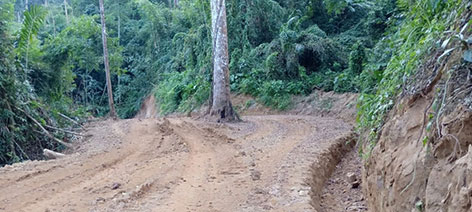MIAO, 11 Feb: Ever since the Miao-Vijaynagar (MV) road, which was under the public works department (PWD), changed hands and was transferred to the rural works department (RWD), the much-talked-about project has been drowning in troubled waters.
After bringing the road under the RWD, the then UPA government at the Centre in 2011-2012 decided to take up the strategically significant road project under its flagship programme, the Pradhan Mantri Gramin Sadak Yojana (PMGSY).
With much fanfare and haste, the foundation stone of the country’s longest link road from Miao to Vijaynagar, spanning 157 kms, was officially laid at Miao by Union Rural Development Minister Jairam Ramesh on 29 February, 2013, in the presence of the then chief minister Nabam Tuki.
The MV road was originally constructed by the CPWD in 1973 and was revived in 2000 upto 61 kms with a few HPCs and bridges at selected rivers/streams upto Burma Nallah (61 kms from Miao). It was proposed under Phase 10 of the PMGSY in 2011-12 for upgrading.
Under the initiative of the PWD, the blocks on the road were cleared upto Vijaynagar by providing log bridges and temporary bamboo bridges and culverts, only to be subsequently washed away in the following monsoon during 2011-12.
The entire stretch of the road requires blacktopping, long span bridges, culverts, and minor bridges over numerous rivers and streams along the road, but owing to persistent objection from the forest authorities the tarred road couldn’t be proposed, as alleged by the executing agencies.
However, amidst hindrances, an estimate was prepared for formation width of 6 m (widening) and carriageway of 3 m non-tarred gravel-based road for a length of 100.46 kms and blacktop road of 57.10 kms for a carriage way of 3 m in compliance with the terms and conditions set by the NTCA, PCCF (WL&BD) & CWLW.
The DPR was prepared by calling a consultancy with total length of 157.56 kms with initial cost of Rs 375 crore. But the cost of project got reduced to Rs 342.2 crore at STA, Jorhat, followed by another cost deduction at NRDDA.
After numerous recasting and site verification, the road was cleared and sanctioned on 26 July, 2013 with an estimated amount of Rs 145.6 crore only.
The sanctioned amount was meant for construction of a pavement, long span bridges, minor bridges, culverts, and causeways along with animal corridors. It also included widening of 157.56 kms, PMC 20 mm thickness, gravel base 100 mm to 150 mm thickness, WBM-II and WBM-III with thickness of 75 mm, along with earthen side drain and protective works, etc.
When the MV road was transferred to the RWD, it was said that the project under the PMGSY would get through in three years but even after eight-nine years of construction, it is still miles away from completion. Over the years, there have been allegations of varied magnitudes, often terming the RWD of being a non-performing department.
There are many reasons behind the delay. Since 113 kms stretch of the road passes through the Namdapha National Park (Project Tiger) between Namdapha Entry Gate at M’Pen (6.60 km from Miao) to Tilu hka at 119.40 kms, there is an allegation that the National Tiger Conservation Authority and the Wild Life & Biodiversity Authority were interrupting in the implementation of the project by exhibiting reluctancy in giving statutory forest clearance in initial stages which resulted in the road project getting hanged for nearly two years from the date of sanction order.
Another serious allegation is that the wildlife and forest authorities are claiming 1 percent of project cost as monitoring and supervision charges. But till date the RWD hasn’t paid.
Minor minerals are abundant in nearby riverbeds within the jurisdiction of the national park but the forest department does not allow the executing agencies to collect the minerals like boulder and sands shingles from adjoining quarries.
The contractors are forced to collect the construction materials from far-off places, covering a distance of 40 kms outside the national park. At the same time, the contractors are not allowed to clear the mudslides, and landslides too.
The construction agencies are also not allowed to fell the trees along the road and new cutting in the event of breach of formation width. If they are allowed to extract minor minerals from territorial jurisdiction of the national park, the construction cost could have been reduced to considerable extent and can improve the construction time period.
Construction labourers are not allowed to set camps inside the tiger reserve and movement of vehicles as well as entry of labourers into the tiger reserve is strictly prohibited. Before every entry into the reserve, a prior permission is to be obtained, indicating vehicle numbers and number of labourers likely to enter inside the reserve which has become impediment even for engineers monitoring, contractors and supervision.
As per the WL&BD and NTCA norms, the work progress in 133 kms is to be monitored by forest officials and cutting of trees, vegetations, etc, are not allowed.
At many chainages, there is a sinking and sliding zone where mudslides and landslides occur, making it difficult for loaded vehicles to ply in every normal rainfall.
But the needed change and alterations in alignment and extra widening couldn’t be done owing to wildlife interventions.
The full stretch of 110 kms remains marshy and muddy throughout the year due to passes of road alignment in shadow side of the mountain. This can be done away with soil stabilisation or laying of 800 mm to 900 mm thick GSB layers.
But unfortunately, the WL&BD authority is not allowing extraction of sand shingles, sands and boulders at site within the park.
At many stretches of the road, there are requirement for explosives to clear the blockades and to maintain the alignment of road for required formation width and carriage way of 3m. There are certain stretches where formation width, as well as carriageway, are narrowed in the rocky portion as use of explosive is strictly prohibited inside the park and within 113 km radius.
A heavy rainfall and cloudburst on 19 September, 2016, caused extensive damages to the road surface like breaching the formation width, culverts, bridge abutments, landslides, mudslides and cause ways 42 m at change 7.90 kms. The damage caused by M’Pen Hka was communicated to the chief executive officer, ARRDA, for onward submission to the competent authority with a projected cost of an approximate Rs 6 crore for rectification and restoration works but the government has not allocated any fund for restoration works.
However, the contractors at their cost restored the heavily damaged portions to make it worthy for running vehicles.
Again, in August 2017, massive landslides and mudslides due to cloudburst was recorded wherein the formation width was washed out at various chainages. The already dilapidated steel bridge was partially damaged along with 42 m causeway and approach road for a length of 300 m on sides.
The damaged cause by the M’Pen river restored in the previous year was again damaged completely for which damaged estimated cost of Rs 32 crores was submitted to CEO as per format being circulated for FDR. But not a single penny has been released till date.
There are many other unavoidable impediments. Heavy monsoon and retreat rainfall is common in our state, but the condition is too excessive within the national park.
The topography and alignment of the existing road is such that even in the event of a light downpour, the surface of the road take months to dry up. The existing alignment of the road is in the shadow or leeward side of the mountain.
Hence, there is no sunray at the entire stretch of 110 kms which remains marshy and moist throughout the year, causing frequent landslides, mudslides and sinking of pavement even in medium and light downpour. Only 3-4 months in a year are ideal for work.
At present, the contractors are laying GSB thickness of 450 mm to 1500 mm in most of these stretches, whereas there is a provision of 150 mm thickness in the DPR. The RWD had apprised the government but the assured additional fund of Rs 39.42 crore is yet to be sanctioned.
Unless there is proper coordination between the RWD and the forest (wildlife) authorities, the possibility of getting the road through is still a distant dream.







